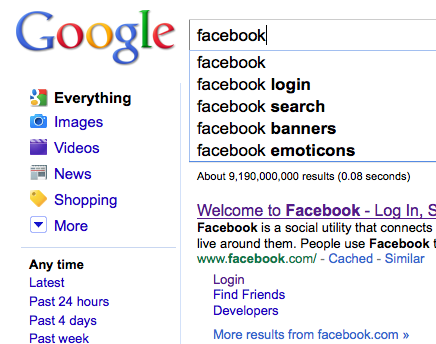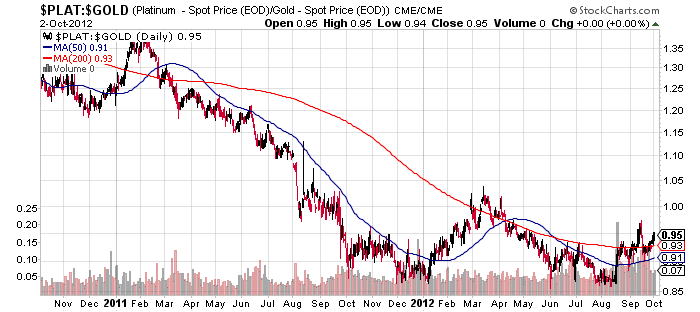 Author: Chris Dixon
Author: Chris Dixon
It is widely believed that Facebook presents a significant competitive threat to Google (Nasdaq: GOOG). Google itself seems to believe this – Larry Page recently said that all employees would have their bonuses tied to the success of Google’s social strategy.
Why does Facebook present a threat to Google? A few reasons:
– The utility of Google’s core product – web search – depends on the web remaining fragmented and crawlable. Facebook has become the primary place web users spend their time and create content, and is mostly closed to Google’s crawlers.
– Facebook controls a large percentage of ad impressions and will likely launch an off-Facebook.com display ad network to compete directly with Google’s display ad business (built from its $3.1B acquisition DoubleClick). It is generally thought that display ads will become a larger portion of online advertising spend (versus direct response text link ads) as more brand advertising moves online.
– There are many other “wildcard” risks – e.g. Facebook competing with Google (and Apple (Nasdaq: AAPL), Paypal (Nasdaq: EBAY) etc.) in payments, Facebook gaining power on mobile (threatening Android), and the possibility of a greater share of internet intent harvesting happening on Facebook through not-yet-released features like a search and/or shopping engine.
When going after Facebook, Google has at least three key strategic choices to make:
Strategic choice #1: Should Google try to make social networking commoditized or new profit center? (For more about what I mean by this, please see this post on Google’s overall strategy and these posts on “commoditizing the complement” here, here and here).
The advantage of creating a new social networking profit center is obvious: if you win, you make lots of money. The advantage of commoditizing social networking is that although you forgo the potential direct profits, you open up a wider range of pricing and product options. For example:
– When you try to commoditize a product, you can offer a product for free that other companies charge for. This is what Google did with Android vs iOS and Google Apps vs Microsoft Office. Of course, making social networking free to users won’t work since Facebook doesn’t directly charge users (I say “directly” because they make money off advertising & payment commissions, among other ways). However reducing the cost to zero for 3rd-party developers like Zynga who have to pay Facebook large commissions would entice them toward a Google platform (note that, not coincidentally, Google invested $100M in Zynga).
– Interoperate / embrace open standards – Normals don’t care whether a product uses open standards, but by interoperating with other social networks, messaging systems, check-in services, etc., Google could encourage 3rd-party developers to build on their platform. If Google chose, say, RSS for their messaging system, it would already work with tens of thousands of existing tools and websites and would be readily embraced by hackers in the open source community. The web itself (http/html) and email (smtp) are famous examples where the choice to open them unleashed huge waves of innovation and (eventually) killed off closed competitors like AOL.
Strategic choice #2: How should Google tie its new social products into its existing products?
Besides a mountain of cash ($30B net, generating $10B more per year), Google has many existing assets on top of which to build. Google Buzz tried to build off of the “implicit social network” of Gmail contacts, which hasn’t seemed to work so far and raised privacy concerns.
Google’s recent mini-launch of its “+1″ button seems to be good use of the strategy known as “anchoring”. Google is apparently trying to create a federated network where websites embed +1 buttons the way they embed Facebook’s Like button except the +1 button would be a signal into Google’s organic ranking algorithm (as an aside, this is where Gmail becomes useful as having millions of logged in users makes spamming +1 buttons much harder). Websites care a lot about their Google organic search rankings (which is why, for example, helping websites improve their rankings is multibillion-dollar industry). A button that improved search rankings would likely get prominent placement by many websites. Making +1 appealing to users is another story. The user value is much clearer for the Facebook Like and Twitter Tweet buttons – you send the link to your friends/followers. Providing value to users in addition to websites is a good reason for Google to acquire Twitter (something I think is inevitable if Google is serious about social – see below).
Finally, Android and YouTube are intriguing potential anchors for a social strategy. I’ll leave it to smarter people to figure out exactly how, but products with such large footprints always present interesting tie-in opportunities.
Strategic Choice #3: Should Google buy or build?
Historically, it is very rare to see tech companies adjust their “DNA” from within. Google’s best new lines of business over the past few years came through the acquisitions of YouTube and Android. Moreover, these acquisition were unusual in that they were left as semi-independent business units. Facebook’s hold on social is incredibly strong – besides the super-strong network effects of its social graph, Facebook has made itself core infrastructure (e.g. Facebook Connect) throughout the web. If Google really wants to catch up, they’ll need to go back to the strategy they succeeded with in the past of acquiring relevant companies and letting them run as separate business units.
* Disclosure: I’m an investor in a bunch of startups, so you could reasonably argue I’m highly biased here.
* * * *
Covestor models that hold GOOG currently – click through for more info on the models:
- High Growth from Joseph Mjelde
- Suncoast Equity from Suncoast Equity Management
- Fortune 100 from Philip Dhingra
- Performance with Protection from Leif Eriksen
- Management Access from Douglas Estadt
- Large Cap Growth from AlphaMark
- Large Cap Core Equity from ASB Capital



